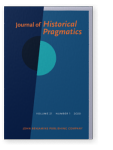Vol. 21:1 (2020) ► pp.28–52
Old English law-codes
A synchronic-diachronic genre study
Law language is a cover-term for different genres of legal texts. The genre of law is characterized as being written, legislative and formal. Quantitative studies on the textual and linguistic structure of Old English (oe) law-codes are lacking so far, but both aspects are analysed in this paper on the basis of a corpus of about 20,000 words. The results of the quantitative-qualitative analysis are compared to oe wills on the one hand, and to Early Modern English (emode) and Present-Day English (pde) statutes on the other. The synchronic comparison of oe law-codes and oe wills reveals that the text structure and the linguistic profile of the genres are very similar. The conclusion to be drawn from this result is that genre properties largely determine the textual and linguistic profile of texts in a given period. The diachronic comparisons show marked differences in the linguistic profile of oe law-codes and statutes of later periods.
Article outline
- 1.Legal English as a research topic in corpus linguistics
- 2.Earlier studies on English legal writing
- 3.Old English law-codes
- 4.Aim and structure
- 5.Corpus and research method
- 6.Corpus analysis
- 6.1Text/discourse structure
- 6.1.1The identification of the legislator
- 6.1.2The provisions
- 6.1.3The optional part
- 6.2Linguistic features
- 6.2.1Sentence length
- 6.2.2Sentence structure
- 6.2.2.1The number of clauses per sentence
- 6.2.2.2Frequency and types of subordinate clauses
- 6.2.3The verbal syntagm
- 6.2.3.1Tense
- 6.2.3.2Mood
- 6.2.3.3Modality
- 6.2.3.4Voice
- 6.1Text/discourse structure
- 7.Comparisons
- 7.1
oe law-codes and oe wills
- 7.1.1Text/discourse structure
- 7.1.2Linguistic features
- 7.1.2.1Sentence length
- 7.1.2.2Sentence structure
- 7.1.2.3The verbal syntagm
- 7.2
oe law-codes and statutes of later periods
- 7.2.1Text/discourse structure
- 7.2.2Linguistic features
- 7.2.2.1Sentence length
- 7.2.2.2Sentence structure/complexity
- 7.2.2.3The verbal syntagm
- 7.1
oe law-codes and oe wills
- 8.Summary and conclusion
- Notes
-
References
